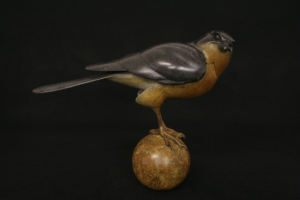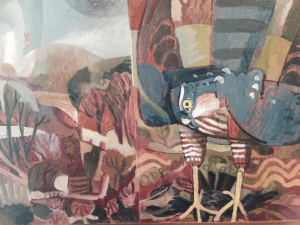 Dr Roger Clarke was a world expert on the analysis of the pellets of birds of prey. They are the undigested items of prey – fur, feathers and bones – which are regurgitated before the bird goes hunting again. I can see him now taking a pellet from where it has been soaking in a dish of water and placing it on a sheet of blotting paper in front of him. Then, using a pair of mounted needles, he gently teased the pellet apart. The fur which held the pellet together would be discarded. All that was left would perhaps be a skull – was it a vole? What kind of vole? Or it might be a bird’s skull. Roger’s encyclopaedic knowledge enabled him to identify what species a Hen Harrier in Norfolk had been preying on.
Dr Roger Clarke was a world expert on the analysis of the pellets of birds of prey. They are the undigested items of prey – fur, feathers and bones – which are regurgitated before the bird goes hunting again. I can see him now taking a pellet from where it has been soaking in a dish of water and placing it on a sheet of blotting paper in front of him. Then, using a pair of mounted needles, he gently teased the pellet apart. The fur which held the pellet together would be discarded. All that was left would perhaps be a skull – was it a vole? What kind of vole? Or it might be a bird’s skull. Roger’s encyclopaedic knowledge enabled him to identify what species a Hen Harrier in Norfolk had been preying on.
If Roger had a favourite bird it was probably the Hen Harrier. He was one of the first experts to state that a proportion of the winter visitor Hen Harriers we see in England, particularly those in Norfolk, are from Scandinavia. When Roger died in 2007 it seemed very appropriate that The Hawk and Owl Trust should sponsor an award for the best work of art depicting a bird of prey at the annual Society of Wildlife Artists exhibition in London.
It’s been my task to go to the Mall Galleries in London every year and chose a work of art of which I think Roger would have approved. I try and arrive the day before the exhibition opens. This year, after wandering round a couple of times, I had no hesitation in picking out the exquisite sculpture in bronze by Adam Binder of a Sparrowhawk at the exact moment after making a successful kill. The tension in the hawk’s body as it looks round anxiously is beautifully realised.
Adam told me that he works in wax on an armature to produce the initial model. He likes wax because it is soft to begin with and excellent for creating the larger forms, the wings, the body and head. It is a perfect modelling material because when it starts to harden he can start to cut in the detail, the talons and the beak of the hawk. A mould is then made, the wax is melted away, and the first bronze can be cast.
Like Roger I am an avid bird art collector and recently I received an email from Sarah Whittley, who runs The Pinkfoot Gallery at Cley, announcing their winter 2015 exhibition. I was particularly taken by the work of a new artist they had just taken on. His name is John Foker and he trained at The Norwich School of Art. Sarah wrote: “We’re very excited to have his work on our walls. It really is beautiful, so beautiful it’s hard not to want to pick them up and hold them.” Underneath there was a photo of one of his paintings, an oil of a Sparrowhawk simply called The Hawk.
 A few days later, my wife, Liza, and I called in at The Pinkfoot Gallery and we made a ‘bee-line’ for John Foker’s painting called The Hawk. It was a very original interpretation of a Sparrowhawk, verging on the abstract. It is an oil painted on two bits of board. On the left is a landscape, on the right a very bold painting of a cock Sparrowhawk. It has just made a“kill”. The bird’s wings and tail are raised and it is looking down at the Blackbird clutched in its talons.
A few days later, my wife, Liza, and I called in at The Pinkfoot Gallery and we made a ‘bee-line’ for John Foker’s painting called The Hawk. It was a very original interpretation of a Sparrowhawk, verging on the abstract. It is an oil painted on two bits of board. On the left is a landscape, on the right a very bold painting of a cock Sparrowhawk. It has just made a“kill”. The bird’s wings and tail are raised and it is looking down at the Blackbird clutched in its talons.
I talked to Johnny about this painting. I asked him ‘why was it in two halves?’ He laughed. ‘It was two different days. I went for a walk where I live in Durham. I painted an evocation of a Skylark singing without actually seeing him. There’s a patch of golden light in the sky – that’s where the Skylark is but you can’t actually see him. Then the next day there was a complication. I was still thinking about the Skylark when a Sparrowhawk dashed down and grabbed at a songbird on our lawn right in front of me. I snapped out of my reverie. It was quite a rude awakening. I just put the two paintings together, it just seemed right.’
I am looking at Johnny’s painting now, it’s hanging on the wall of my study. It is a masterpiece.
For anyone who wants to see Sparrowhawks in action I recommend a DVD called ‘The Private Life of the Sparrowhawk’. It was made by Dave Culley and has a narration by Chris Packham. Dave used over a dozen CCTV cameras to record some of the most intimate and exciting moments during a year in the life of a pair of Sparrowhawks. It runs 50 minutes and can be obtained by contacting Dave Culley on his website at http://www.sparrowhawk-island.co.uk. It is a brilliant film.
